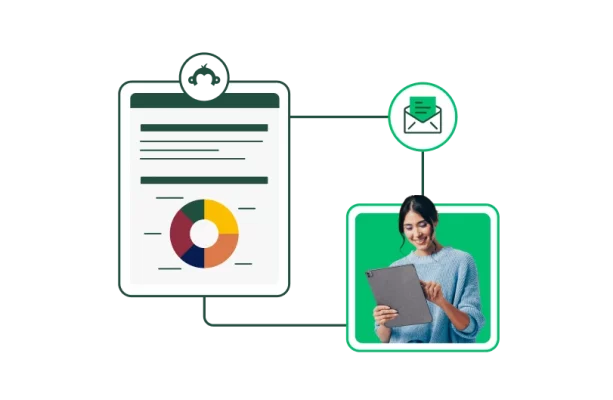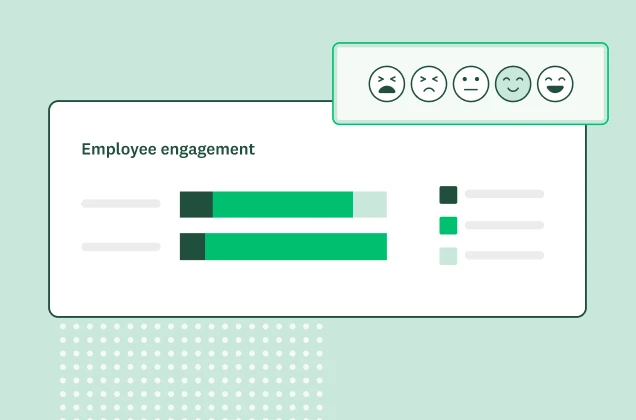20 self evaluation questions that managers can use for employee performance reviews

If you’re a manager or an HR professional, you’re probably familiar with the employee feedback cycle. Peers evaluate each other and their managers, delivering timely feedback that can help everyone make important changes.
But if you want to attract and retain top talent and keep employees engaged, you need to make self evaluation and reflection an important part of your workplace culture. Keep reading to learn how to write a self evaluation survey and see examples of our top survey questions.
What is employee self evaluation?
Employee self evaluation occurs when workers answer questions about how they performed during a set period of time or in response to a specific event. Employees are encouraged to give thoughtful answers and use this time to reflect on their work.
Why employee self evaluation surveys are important
Many organizations regularly conduct performance reviews to determine employee promotions and growth areas. Employees give feedback to their peers, managers, and subordinates.
Self evaluation forms help managers assess employee performance from a different perspective. When employees answer self-evaluation questions, they can showcase their own achievements, ask for help where they need it, and convey their professional and personal goals. This helps managers identify opportunities for their employees, boosting morale and overall job satisfaction.
How to write effective self evaluation questions
The best performance self-evaluation review questions will vary depending on what you want to know. Here’s what to consider when choosing questions for your self evaluation survey.
- Objectives: Are you conducting employee self-evaluation reviews to learn more about productivity, happiness, workplace culture, employee engagement, or something else?
- Company values: Your company values will influence what your business holds as most important in employee performance.
- Tracking metrics: If you already have an active employee performance review process, you might have specific metrics that you will measure. These will influence the best self-evaluation review questions to use.
- Job role: The self-evaluation questions you ask a department leader won’t be the same as you ask a middle manager.
- Professional development: Your business should offer the opportunity for employees to work toward professional development. It’s helpful to ask employees how well their career is progressing.
Examples of self evaluation questions to ask employees
Looking for inspiration? Here are some expert-written performance review survey questions you can ask your employees.
- On a scale of 1-10, how effectively do you believe you have contributed to the objectives of your role?
- Based on your performance this quarter, what specific achievements are you most proud of?
- Are there any particular areas of your job that you find motivating or fulfilling?
- Are there any areas of your job that you find taxing or difficult?
- What were your primary goals over the last quarter, and to what extent do you feel you met them?
- Is there anything that would have helped you meet your goals?
- Do you feel like you are advancing in your career?
- What could our organization do to support your career advancement?
- What job-specific goals do you have for next quarter?
- On a scale of 1-10, how would you rate your engagement over the last quarter?
- On a scale of 1-10, how would you rate communication standards in your department?
- What work are you performing that falls outside your original job description?
- On a scale of 1-10, how would you rate your work-life balance over the last quarter?
- Do you feel like your managers are helping you manage stress in the workplace?
- What could your managers do to improve your experience in the workplace?
- What do you like most about your current job role?
- Is there anything you would improve about your current job role?
- Are you proud of the work you contributed during this period?
- Do you feel like you align with the company values?
- Have you effectively managed stress over the past few months?

Employee self evaluation survey best practices
Self-evaluation reviews are an opportunity for employees to reflect on their performance, skills, and workplace behavior. But if you want to get dependable answers, you need to ask questions and structure your survey correctly. Here are some best practices to keep in mind when creating your employee self-review survey.
Set a goal for your self evaluation survey
The first step to writing effective survey questions is to set a goal for your survey. This will help you write focused questions and keep your evaluation survey short.
For example, if you just want to gather in-depth information about employee satisfaction, you should only ask questions that address this topic. However, you can also use employee self evaluation surveys to explore different dimensions of the employee experience. Just remember to limit the number of questions in your survey so employees are more likely to give thoughtful, complete responses.
Be clear and concise
Try to keep your performance self-evaluation survey as concise as possible to make the self-evaluation process more inviting to employees. A lengthy and complicated survey can cause frustration and anxiety, which may result in inaccurate responses.
Moreover, using clear and straightforward questions can ensure that the employees understand the purpose of the survey and can provide honest and accurate answers. This can help employers gain valuable insights and feedback to enhance their workplace and address any concerns or issues that employees may have.
It is also beneficial to briefly explain how the collected data will be used before presenting the questions so employees feel more comfortable and open when answering the survey.
Avoid bias
When writing good survey questions, neutral language is important. The way you phrase a question can influence how employees respond.
For example, consider this question: “Explain how you consistently exceeded expectations in your work during the last quarter.” This question is biased and can result in unreliable data because it leads employees to focus on going beyond their responsibilities.
Instead, you can avoid leading or loaded questions using neutral language: “Evaluate your performance over the last quarter.” This question allows the employee to provide honest feedback without any specific agenda.
Collect employee self assessments regularly
Regularly conducting performance self evaluation reviews is an effective way to monitor your employee' experience throughout their journey with your company. It's a good idea to launch these surveys at least once every quarter.
By conducting these surveys regularly, companies can monitor employee performance closely and obtain a steady flow of data that can be used to improve the employee experience over time. You can also use this data to benchmark and track employee engagement and measure the effectiveness of your training and development programs.
Take action on employee feedback
To make the most of your collected feedback, it's important to talk to your employees after completing their evaluations. A follow-up or check-in will give you the opportunity to clarify any feedback, identify any further steps that need to be taken, and discuss potential solutions to any problems that have been identified.
For example, if someone says they don't feel supported, you might need to take steps to improve their experience, such as providing additional training, assigning a mentor, or connecting them with resources to help them succeed.
Likewise, if someone is showing above-average commitment, it's important to provide appropriate rewards or employee recognition to keep them motivated and happy.
By actively listening to your employees, clarifying their feedback, and taking appropriate action, you can create a healthy work culture where employees are committed to your organization’s success.
Conduct stronger performance reviews with SurveyMonkey
It’s clear that self evaluation is a crucial part of any employee feedback cycle. Now you can give your employees the best way to answer important questions about their work. Learn how SurveyMonkey can help you conduct reviews and manage employee performance all in one place.
Discover more resources

HR toolkit: Make employee experience your competitive advantage
HR leaders can use this toolkit to help drive exceptional employee experiences.

How to use Forms to enhance your survey experience
How do surveys and forms differ? Learn how to combine form data with survey feedback for seamless events and experiences.

Get the feedback you can act on with online evaluation forms
Unlock the power of feedback with SurveyMonkey's online evaluation forms. Start with our form builder today!

HR quickstart guide: employee surveys from hire to retire
Explore best practices for conducting employee feedback surveys throughout the employee lifecycle. Learn how to gather insights to enhance employee engagement, retention, and performance.